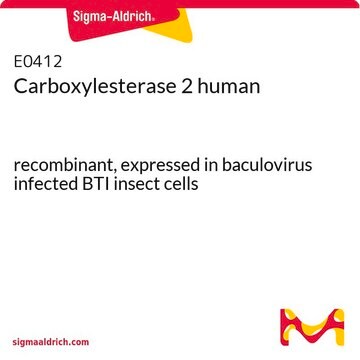B4186
Butyrylcholinesterase human
vial of ≥4 units
Synonyme(s) :
Acylcholine acyl-hydrolase, Choline esterase, butyryl, Pseudocholinesterase
Se connecterpour consulter vos tarifs contractuels et ceux de votre entreprise/organisme
About This Item
Produits recommandés
Forme
powder
Niveau de qualité
Activité spécifique
≥50 units/mg protein
Conditionnement
vial of ≥4 units
Numéro d'accès UniProt
Température de stockage
2-8°C
Informations sur le gène
human ... BCHE(590)
Vous recherchez des produits similaires ? Visite Guide de comparaison des produits
Application
BchE, from Sigma, has been used to determine butyrylcholinesterase inhibition by various test compounds .
Butyrylcholinesterase human has been used to study its role as a modulator of pathological features of Alzheimer′s disease (AD) in vivo.
Actions biochimiques/physiologiques
Butyrylcholinesterase (BChE) is a serine hydrolase that shares substantial structural similarities with acetylcholinesterase (AchE) but has different substrate and inhibitor specificities. BChE is found in the serum, hemopoietic cells, liver, lung, heart and the central nervous system of vertebrates.
Butyrylcholinesterase (BChE) is a serine hydrolase that shares substantial structural similarities with acetylcholinesterase (AchE) but has different substrate and inhibitor specificities. It is found in the serum, hemopoietic cells, liver, lung, heart and the central nervous system of vertebrates. BChE hydrolyzes large esters of choline such as butyrylcholine and benzoylcholine. Selective inhibition of BChE activity can be used in the detection of organophosphates. BchE may be used to treat organophosphate toxicity. It is a critical target for Alzheimer′s disease (AD) therapy.
Définition de l'unité
One unit will hydrolyze 1.0 μmole of butyrylcholine to choline and butyrate per min at pH 8.0 at 37 °C. The activity obtained using butyrylcholine as substrate is ~2.5 times that obtained using acetylcholine.
Remarque sur l'analyse
Starting material individually donor tested and found negative for HIV I & II antibodies, Hepatitis B surfaceantigen, and Hepatitis C antibodies.
Mention d'avertissement
Danger
Mentions de danger
Conseils de prudence
Classification des risques
Resp. Sens. 1
Code de la classe de stockage
11 - Combustible Solids
Classe de danger pour l'eau (WGK)
WGK 3
Point d'éclair (°F)
Not applicable
Point d'éclair (°C)
Not applicable
Faites votre choix parmi les versions les plus récentes :
Déjà en possession de ce produit ?
Retrouvez la documentation relative aux produits que vous avez récemment achetés dans la Bibliothèque de documents.
Les clients ont également consulté
Butyrylcholinesterase: an important new target in Alzheimer's disease therapy
Greig NH, et al.
International Psychogeriatrics / IPA, 14(S1), 77-91 (2002)
The key role of butyrylcholinesterase during neurogenesis and neural disorders: an antisense-5? butyrylcholinesterase-DNA study
Mack A and Robitzki A
Progress in Neurobiology, 60(6), 607-628 (2000)
Cholinesterases and engineered mutants for the detection of organophosphorus pesticide residues
Xu YL, et al.
Sensors, 18(12), 4281-4281 (2018)
The apolipoprotein E varepsilon4 allele plays pathological roles in AD through high protein expression and interaction with butyrylcholinesterase
Darreh-Shori T, et al.
Neurobiology of Aging, 32(7), 1236-1248 (2011)
Neurobiology of butyrylcholinesterase.
Sultan Darvesh et al.
Nature reviews. Neuroscience, 4(2), 131-138 (2003-02-04)
Notre équipe de scientifiques dispose d'une expérience dans tous les secteurs de la recherche, notamment en sciences de la vie, science des matériaux, synthèse chimique, chromatographie, analyse et dans de nombreux autres domaines..
Contacter notre Service technique









